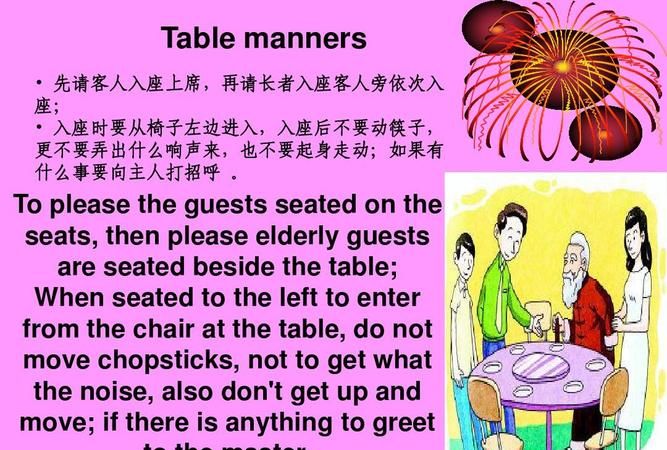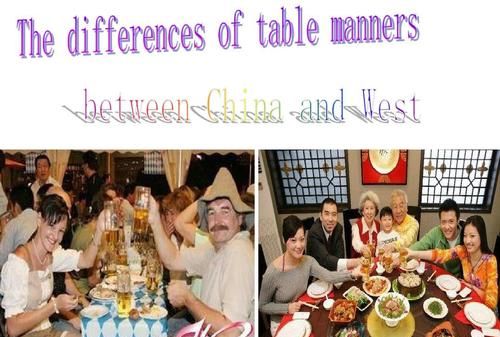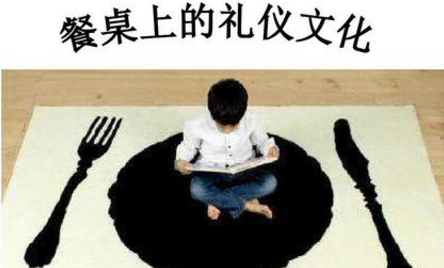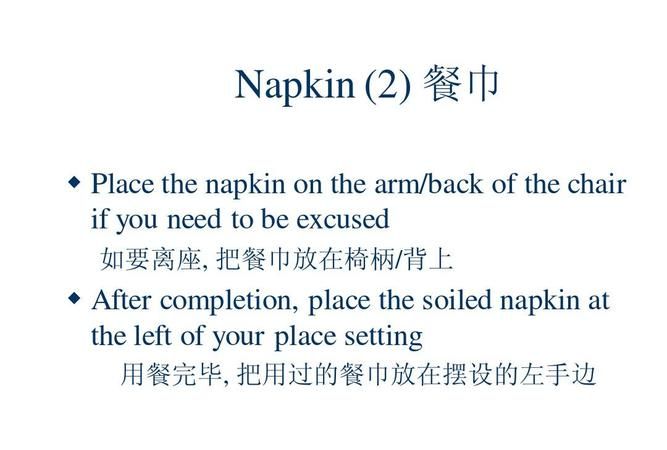本文目录

中西方餐桌礼仪差异英语作文
The Differences Between Chinese and Western Table Manners/etiquette
Comparison of Chinese and western Table Manners/etiquette
table manners
UK [ˈteɪbl mænəz]
US [ˈteɪbl mænərz]
n.
餐桌规矩;进餐礼节
table etiquette
UK [ˈteɪbl ˈetɪkət]
US [ˈteɪbl ˈetɪkət]
餐桌礼仪
manners是常使用复数形式,指非常普通的、连孩子都应掌握的基本的礼仪规范;etiquette则更为讲究,要比manners复杂,常随着形势的变化而改变。
Etiquette (来自法语)and manners are synonyms, but do have slightly different meanings.
Etiquette is a code of polite conduct based on social acceptance and efficiency. Simply, it means to follow rules for efficiently or politeness. Sometimes, rules of etiquette are archaic (old-fashioned) and don't make sense nowadays.
For example, it is good etiquette to sit with your back straight.
It is good etiquette to not chew loudly when at the dinner table.
It is good etiquette to dress neatly for a formal occasion.
Etiquette may change in different cultures. For example, it could be good etiquette to chew loudly when eating your food (this is just an example, haha).
Manners are polite behaviors that reflect an attitude of consideration, kindness and respect for others.
For example, saying "please" and "thank you" are good manners. Saying "excuse me" if you need to get someone's attention instead of shouting rudely is good manners. Not interrupting someone while they are talking is good manners.
Good manners are usually universal and don't change in different cultures.
Of course, the main difference on the Chinese dinner table is chopsticks instead of knife and fork, but that's only superficial. Besides, in decent restaurants, you can always ask for a pair of knife and fork, if you find the chopsticks not helpful enough.
tableware
UK [ˈteɪblweə(r)]
US [ˈteɪblwer]
n.
(商店用语)餐具
chopsticks
UK [ˈtʃɒpstɪks]
US [ˈtʃɑpˌstɪks]
n.
筷子
chopstick的复数
The real difference is that in the West, you have your own plate of food, while in China the dishes are placed on the table and everyone shares ,Perhaps it’s one of the things that surprises a Western visitor most is that some of the Chinese hosts like to put food onto the plates of their guests. In formal dinners, there are always "public" chopsticks and spoons for this purpose, but some hosts may use their own chopsticks. This is a sign of genuine friendship and politeness. It is always polite to eat the food. If you do not eat it, just leave the food in the plate.
People in China tend to over-order food, for they will find it embarrassing if all the food is consumed. When you have had enough, just say so. Or you will always overeat!
Chinese table manners of families have no intrinsic quality even there are different region and position. No matter three meals a day or guest's arrival, always bowls with chopsticks, food with soup. There is no rule for how to put the tableware. What people care about more are not the gorgeous tableware but the sumptuous food. People's dining position reflects the most obvious etiquette of Chinese table manners. In ancient society, men are supreme, and women are not allowed to sit with men on the same table. Although this is modern society, this kind of ancient etiquette still remains. Today in China, the phenomenon that men sit on the table before women can be found everywhere. The master of a family usually sits on the first-class seat. The first-class seat is usually near the interior of a room facing to the door. Once there is a guest, the master will offer the first-class seat to the guest politely. If it is an ordinary meal of family, families should start after the elder. If there is a guest, the master offer the food to the guest is essential from the beginning to the end. And the tradition of urging others to drink is also a special phenomenon.
Here are some characteristics on Chinese eating:
The real difference is that in the West, you have your own plate of food, while in China the dishes are placed on the table and everyone shares ,Perhaps it’s one of the things that surprises a Western visitor most is that some of the Chinese hosts like to put food onto the plates of their guests. In formal dinners, there are always "public" chopsticks and spoons for this purpose, but some hosts may use their own chopsticks. This is a sign of genuine friendship and politeness. It is always polite to eat the food. If you do not eat it, just leave the food in the plate.
People in China tend to over-order food, for they will find it embarrassing if all the food is consumed. When you have had enough, just say so. Or you will always overeat!
Chinese table manners of families have no intrinsic quality even there are different region and position. No matter three meals a day or guest's arrival, always bowls with chopsticks, food with soup. There is no rule for how to put the tableware. What people care about more are not the gorgeous tableware but the sumptuous food. People's dining position reflects the most obvious etiquette of Chinese table manners. In ancient society, men are supreme, and women are not allowed to sit with men on the same table. Although this is modern society, this kind of ancient etiquette still remains. Today in China, the phenomenon that men sit on the table before women can be found everywhere. The master of a family usually sits on the first-class seat. The first-class seat is usually near the interior of a room facing to the door. Once there is a guest, the master will offer the first-class seat to the guest politely. If it is an ordinary meal of family, families should start after the elder. If there is a guest, the master offer the food to the guest is essential from the beginning to the end. And the tradition of urging others to drink is also a special phenomenon.
Here are some characteristics on Chinese eating:
Can I take your order now?
Will you have some soup before the meat course?
吃荤菜前先来点汤好吗?
关于宴会知多少?
banquet
UK [ˈbæŋkwɪt]
US [ˈbæŋkwɪt]
n.
宴会;盛宴;筵席
CET6 · 考研 · TEM8 · GRE · TOEIC
复数:banquets
The state banquet国宴
SITTING
In China, any banquet, only will have one form, will be everybody sits in a circle all round. The banquet must use the round table, this formally has created (营造)one kind of unity, politeness, altogether the interest atmosphere. The delicacy delicacies place(摆放) a table of person's center, it is not only the object which table of people appreciate, taste, is also a table of person sentiment exchange intermedium.
Westerners treat with a long table, men and women sit in the owner at both ends,(男女主人坐在两头) and then the guest of honor men and women in the press and the general order of the guests seating arrangements.
关键词:
a circle
UK [ə ˈsɜːkl]
US [ə ˈsɜːrkl]
一周;一圈
all around
UK [ˌɔːl əˈraʊnd]
US [ˌɔːl əˈraʊnd]
各方面,四周
the round table
UK [ðə raʊnd ˈteɪbl]
US [ðə raʊnd ˈteɪbl]
圆桌
round-table conference
UK [raʊnd ˈteɪbl ˈkɒnfərəns]
US [raʊnd ˈteɪbl ˈkɑːnfərəns]
圆桌会议;举行圆桌会议
圆桌会议指围绕圆桌举行的会议,圆桌并没有主席位置,亦没有随从位置,人人平等。此概念源自英国传说里的亚瑟王与其圆桌骑士在卡默洛特时代的习俗。
圆桌会议是指一种平等、对话的协商会议形式。是一个与会者围圆桌而坐的会议。在举行国际或国内政治谈判时,为避免席次争执、表示参加各方地位平等起见,参加各方围圆桌而坐,或用方桌但仍摆成圆形。直到今天“圆桌会议”已成为平等交流、意见开放的代名词,也是国家之间以及国家内部,一种重要的协商和讨论形式。
a long table
the guests of honor贵宾
The order of dishes in the West(bread eater)
Dinner start with a small dish, which is often called an a starter. After the starter you will get a bowl of soup. The next dish is the main course, it usually is a beefsteak . A vegetable salad will be served. Then a delicious dessert will appear at the table . At last is a cup of tea or coffee.
Starter(英式)
UK [ˈstɑːtə(r)]
US [ˈstɑːrtər]
n.
(主菜之前的)开胃小吃,开胃品;参赛人;参赛的马(或汽车等);(赛跑等的)发令员
TEM8 Vocabulary
复数:starters
Appetizer(北美)
UK [ˈæpɪtaɪzə(r)]
US [ˈæpɪtaɪzər]
n.
(餐前的)开胃品,开胃饮料
GRE · TOEIC
复数:appetizers
The main course 主菜
The order of dishes in China (rice eater)
The meal usually begins with a set of at least four cold dishes, to be followed by the main courses of hot meat and vegetable dishes. Soup then will be served to be followed by staple food ranging from rice, noodles to dumplings. If you wish to have your rice to go with other dishes, you should say so in good time, for most of the Chinese choose to have the staple food at last or have none of them at all.
中文:渴汤 不等于英文drink soup 而是 eat soup.
This is my spoon. I like to eat soup.
这是我的勺子,我喜欢喝汤。
I eat soup with a large spoon.
我用大勺子喝汤。
Manners in the West
1) As soon as the hostess picks up her napkin, pick yours up and lay it on your lap. Sometimes a roll of bread is wrapped in it; if so, take it out and put it on your side plate.
2) The Soup Course
Dinner usually begins with soup. The largest spoon at your place is the soup spoon. lt will be beside your plate at the right-hand side.
3) The Fish Course
If there is a fish course, it will probably follow the soup. There may be a special fork for the fish, or it may be similar to the meat fork. Often it is smaller.
4) The Meat Course
The main Course is usually served by the host himself, especially if it is a fowl or a roast which need to be carved. He will often ask each guest what piece he prefers, and it is quite proper to state your preference as to lean or fat, dark (红肉 )or light (白肉) 。
5) Helping Yourself and Refusing
If a servant passes food around, he will pass the dish in at your left hand so that you can conveniently serve yourself with your right hand. Never serve yourself while the dish is on your right; it is then the turn of your neighbor on the right. It is polite to take some of everything that is passed to you. But if there is something you may not like, you may quietly say: No thank you。
6) Various rules and Suggestions
Sit up straight on your chair;
Do not put much food in your mouth at a time; Drink only when there is no food in your mouth; Try not to get into your mouth anything that will have to be taken out; Do not make any noise when you eat; Do not clean your teeth at the table or anywhere in public, either with your finger or a tooth pick/dental floss , not even with you tongue.
Receiving guests
When a guest receives an invitation to someone's home, it is common but not necessary for the guest to ask, "Could I bring anything?" If the host declines, the guest should not insist, as this insinuates that the host is unable to provide
中文:渴汤 不等于英文drink soup 而是 eat soup.
This is my spoon. I like to eat soup.
这是我的勺子,我喜欢喝汤。
I eat soup with a large spoon.
我用大勺子喝汤。
Manners in the West
1) As soon as the hostess picks up her napkin, pick yours up and lay it on your lap. Sometimes a roll of bread is wrapped in it; if so, take it out and put it on your side plate.
2) The Soup Course
Dinner usually begins with soup. The largest spoon at your place is the soup spoon. lt will be beside your plate at the right-hand side.
3) The Fish Course
If there is a fish course, it will probably follow the soup. There may be a special fork for the fish, or it may be similar to the meat fork. Often it is smaller.
4) The Meat Course
The main Course is usually served by the host himself, especially if it is a fowl or a roast which need to be carved. He will often ask each guest what piece he prefers, and it is quite proper to state your preference as to lean or fat, dark (红肉 )or light (白肉) 。
5) Helping Yourself and Refusing
If a servant passes food around, he will pass the dish in at your left hand so that you can conveniently serve yourself with your right hand. Never serve yourself while the dish is on your right; it is then the turn of your neighbor on the right. It is polite to take some of everything that is passed to you. But if there is something you may not like, you may quietly say: No thank you。
6) Various rules and Suggestions
Sit up straight on your chair;
Do not put much food in your mouth at a time; Drink only when there is no food in your mouth; Try not to get into your mouth anything that will have to be taken out; Do not make any noise when you eat; Do not clean your teeth at the table or anywhere in public, either with your finger or a tooth pick/dental floss , not even with you tongue.
Receiving guests
When a guest receives an invitation to someone's home, it is common but not necessary for the guest to ask, "Could I bring anything?" If the host declines, the guest should not insist, as this insinuates that the host is unable to provide adequate hospitality, especially for more formal situations . such as dinner parties. Hosts accepting such offers should be clear, but not demanding; if one does not think the guest will be able to provide the correct item, politely decline the offers. It is polite to announce your presence when arriving at an informal occasion, such as a backyard barbecue, or if dropping by unexpectedly, although the latter is a faux pas unless the host has previously indicated that such visits are welcome.
Guests wishing to give flowers should consider sending them earlier in the day or the day before a dinner party rather than bring them just as the hostess is busy with last minute dinner preparations. A host might keep a vase handy if he or she suspects that flowers, wile brought by guests.
A guest may offer to help a host, and it is more appropriate in more familiar situations. The host should turn down help offered by people he is less familiar with. Judith Martin
states: "A good guest offers to help but does not insist if the offer is firmly refused ". A good host never requests help and offers mild resistance if it is wanted, but firm resistance if it is not.
General standards
These etiquette topics are relevant in both the United States and Canada and pertain no basic interactions in society. It is a understood that these are general rules to which in certain contexts and depending on the expectations of the parties involved,
there may be exceptions.
Manners in China
1)Spitting Out the Bones
In China it is common practice to spit things out on the table or the floor. Often food has small pieces of bone or other inedible parts that need to be removed from the mouth. Using chopsticks, a hand or a tissue is a polite way around the problem.
2)Touching Tables
Though in the West it is sometimes considered rude to put one's elbows on the dining table, this is quite acceptable in China, particularly when eating noodles.
3)Noise and Smoking
Eating noisily is allowed in China. Slurping, smacking the lips and leaving the mouth open when eating can be viewed as demonstrating enjoyment of the food and a friendly atmosphere in China.
Smoking is also permitted in most Chinese restaurants. A way round this, in larger restaurants, is to request a side room you’re your meal, which will have its own door to insulate you from the noise and smoke.
4)Dessert
Eating something sweet for dessert is not a Chinese custom. Sweet things can be found hidden among everything else on a Chinese menu. Fruit salads and caramel covered apple are Chinese sweet dishes that are popular with Westerners.
5)Drinking
Beer is very popular in China. The other popular alcoholic drink is rice wine. Beware, this can be very strong .In China, drinking alcohol is still mainly a male custom. Male guests are routinely offered alcohol and, cigarettes at meal times. Just politely refuse if you don't want them. An empty glass is always refilled, no matter about protests is that the guest has had enough, as a mark of politeness or good will often a refusal has to be given three times.

十条中国餐桌礼仪英文
1、When helping a woman pull her chair to the table, hold it and guide it. Don’t shove it against the back of her legs.
为女士拉椅子的时候,要把椅子抓住了,留个角度,让女士好走过去。别让椅子腿碰到女士的腿。
2、 If you’re seated at a table with eight or fewer guests, wait for everyone to be served and for the hostess to begin eating before you dig in. At a long banquet table, it’s OK to start when several people are seated and served.
如果就餐人数少于等于八人,那就等所有人都坐好了,女主人开始用餐了,再开动。如果是长餐桌,那么只要有几个人入座进食了,你也就可以开始吃了。
3、All things not having to do with food should remain off the table: keys, clutch bags, cigarette packs, sunglasses, BlackBerrys.
一切和食物无关的东西都不应该出现在餐桌上,包括:钥匙、手袋、烟盒、墨镜还有手机。
4、 Don’t snap your napkin open or unfurl it showily like it’s an Olympic flag.
不要把餐巾展开,看起来像是在展示奥林匹克会旗一样。
5、If you prefer not to have wine while dining out, don’t turn your glass upside down, and don’t make a big deal of saying you don’t drink. Simply place your fingertips on the rim of the glass and say “Not today, thanks.”
如果在用餐时你不想饮酒,不要把酒杯倒过来放,也不要很在意地宣布你不喝酒。只要轻轻地把指尖放在酒杯边缘,说一句“今天不喝,谢谢。”
6、 If you’re eating and want to take a sip, dab your mouth with your napkin to avoid staining the rim of the glass.
如果你在吃东西的时候,想要啜一口饮料的话,那就先拿餐巾把嘴擦干净了,以免在杯子边缘留下残迹。
7、Grabbing a bowl of salad or a saltshaker as it’s being passed to someone who asked for it is the equivalent of cutting in line: greedy and rude.
把原本要递给别人的沙拉碗或者盐瓶从半道截下来,这基本上就等于在说:你是个既贪婪又粗鲁的人。
8、 On the subject of passing: Dishes go counterclockwise, but if someone to your left asks for something, you can hand it directly to him.
餐桌上要传递东西的话,规则一般是逆时针传递。不过,如果坐在你左手边的人想要什么东西时,你也可以直接递给他。
9When you excuse yourself to go to the restroom, just say “Please excuse me.”
想去洗手间的时候,只要说“失陪一下”就可以了。
10、When out with friends or family — even at a fancy restaurant — it’s OK to ask for your leftovers to be wrapped. But don’t do it at a business lunch or dinner.
和朋友家人一起外出用餐,即使是到很高级的餐馆,也可以要求把吃剩下的食物打包带走。不过,如果是在商务宴会上,就不要这么做了。

扩展资料
西餐的餐桌礼仪文化:
1、女士优先。在排定西餐座次时,主位请女主人就座,而男主人位居第二位。
2、以右为尊。在排定座次时,以右为尊。
3、面门为上。面对正门者为上座,背对正门者为下座。
4、交叉排列。男女交叉排列,生人与熟人交叉排列。.
5、美国餐桌礼仪从入座,拿取餐巾、开动、取用餐具、离席,皆有自成一套的规矩,而其中座次与餐具安排,主人会于餐前准备妥当,无需费心。但应熟悉餐具使用顺序及位置功能,以免拿错。
6、女主人宣布晚宴就绪后,男主人引领着客人依次入座,而女主人则走在最后面。有些细心的主人尚会在餐桌上放置姓名卡,以表示座次,若没有此项安排,则其原则如下
7、座次安排以男女分隔而坐为原则。男主客优先入坐,其位置在女主人右边,而女主客则在男主人右边。其他夫妇则以对角方式而坐。男女夫妇分坐显示出美式宴会之开放与活泼,期望借由宴席上座次的安排,增进彼此间之熟稔,并使用餐话题多样化,气氛和乐
8、入座原则系客先入座,长者较年轻者先入座,已婚较未婚先入座,陌生人较熟识客人或家人先入座。
参考资料来源:人民网 - 吃西餐讲究多 西方餐桌礼仪知多少

以上就是关于好的餐桌礼仪有哪些英文 ,有关英文版餐桌礼仪的全部内容,以及好的餐桌礼仪有哪些英文 的相关内容,希望能够帮到您。

